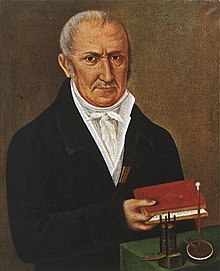Personal Life and Career
– Volta was born in Como, Italy in 1745.
– His father, Filippo Volta, came from a noble lineage.
– His mother, Donna Maddalena, belonged to the Inzaghi family.
– Volta married Teresa Peregrini, an aristocratic lady from Como.
– They raised three sons named Zanino, Flaminio, and Luigi.
– In 1774, Volta became a professor of physics at the Royal School in Como.
– He improved and popularized the electrophorus, a device that produced static electricity.
– Volta studied the chemistry of gases and discovered methane.
– He researched electrical capacitance and developed means to study electrical potential difference and charge.
– In 1779, he became a professor of experimental physics at the University of Pavia.
Volta and Galvani
– Luigi Galvani discovered animal electricity using frogs’ legs and different metals.
– Volta replaced the frogs’ legs with brine-soaked paper and discovered the electrochemical series.
– He invented the voltaic pile, an early electric battery that produced a steady electric current.
– Volta determined that zinc and copper were the most effective metals for producing electricity.
– The voltaic pile consisted of cardboard soaked in brine as electrolyte.
Early Battery
– Volta’s battery was one of the first electrochemical cells.
– It consisted of zinc and copper electrodes with sulfuric acid or saltwater brine as electrolyte.
– Zinc was oxidized to zinc cations, creating electrons that moved to the copper electrode.
– Hydrogen gas was formed at the copper electrode, while sulfate anions migrated to the zinc anode.
– The cell had disadvantages such as the accumulation of hydrogen gas and the hazardous nature of sulfuric acid.
Last Years and Legacy
– In 1809, Volta became an associated member of the Royal Institute of the Netherlands.
– He was made a count by Napoleon Bonaparte in 1810.
– Volta retired in 1819 to his estate in Camnago, Italy.
– He died on March 5, 1827, at the age of 82.
– Voltas remains were buried in Camnago Volta.
– The Tempio Voltiano memorial and museum celebrate Volta’s legacy in Como.
– The Voltian Foundation promotes scientific activities in the Villa Olmo.
– Volta’s experimental studies and inventions were conducted near Como.
– The Aula Volta, a physical theater, was constructed based on Volta’s lectures.
– The SI unit of electric potential, the volt, is named in his honor.
Religious beliefs and Publications
– Volta was raised as a Catholic and maintained his belief throughout his life.
– Some people accused him of being irreligious because he didn’t become a clergyman as his family expected.
– Speculation about his possible unbelief arose from the fact that he didn’t join the Church or actively participate in its activities.
– Volta declared his faith in a written statement, emphasizing his attachment to the Roman Catholic religion and his unwavering belief.
– He acknowledged his shortcomings but affirmed his constant faith in God and the importance of studying religious grounds and apologetics.
– ‘De vi attractiva ignis electrici, ac phaenomenis inde pendentibus’ (1769) was one of Volta’s notable publications on the attractive force of electric fire and related phenomena.
– Giuliano Pancaldi’s book ‘Volta, Science and Culture in the Age of Enlightenment’ (2003) explores Volta’s scientific contributions within the broader cultural context of the Enlightenment.
– Volta’s letter on electricity excited by the contact of conducting substances of different kinds was published in the ‘Philosophical Transactions of the Royal Society’ in 1800.
– The invention of Volta’s electrical battery in 1799 is considered a significant milestone in the history of science and technology.
– Various sources, including the Royal Society of Chemistry and the Royal Netherlands Academy of Arts and Sciences, have published articles and information on Volta’s life and works. Source: https://en.wikipedia.org/wiki/Alessandro_Volta
Alessandro Giuseppe Antonio Anastasio Volta (/ˈvoʊltə, ˈvɒltə/,Italian: [alesˈsandro ˈvɔlta]; 18 February 1745 – 5 March 1827) was an Italian physicist and chemist who was a pioneer of electricity and power and is credited as the inventor of the electric battery and the discoverer of methane. He invented the voltaic pile in 1799, and reported the results of his experiments in 1800 in a two-part letter to the president of the Royal Society. With this invention Volta proved that electricity could be generated chemically and debunked the prevalent theory that electricity was generated solely by living beings. Volta's invention sparked a great amount of scientific excitement and led others to conduct similar experiments, which eventually led to the development of the field of electrochemistry.
Alessandro Volta | |
|---|---|
 | |
| Born | 18 February 1745 |
| Died | 5 March 1827 (aged 82) Como, Lombardy-Venetia, Austrian Empire |
| Nationality | Italian |
| Known for |
|
| Awards |
|
| Scientific career | |
| Fields | Physics and chemistry |
Volta also drew admiration from Napoleon Bonaparte for his invention, and was invited to the Institute of France to demonstrate his invention to the members of the institute. Throughout his life, Volta enjoyed a certain amount of closeness with the emperor who conferred upon him numerous honours.
Volta held the chair of experimental physics at the University of Pavia for nearly 40 years and was widely idolised by his students. Despite his professional success, Volta was inclined towards domestic life and this was more apparent in his later years when he tended to live secluded from public life and more for the sake of his family. He died in 1827 from a series of illnesses which began in 1823. The SI unit of electric potential is named the volt in his honour.
